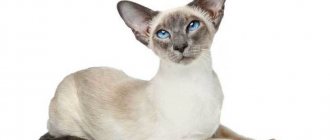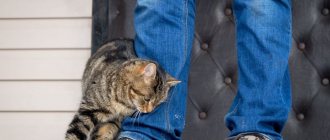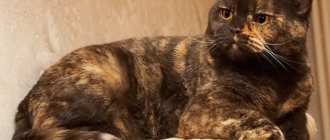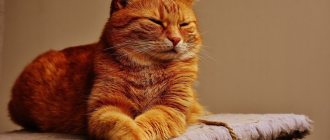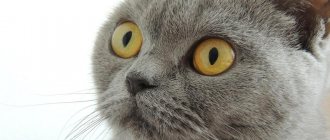Origin story
The history of the Egyptian Mau goes back thousands of years. Ancient Egypt, rich and amazing in its grandeur, however, even sharp spears and an army of thousands could not cope with sneaky small rodents and poisonous snakes that spoil supplies and pose a real threat to human health. Therefore, both rich and poor allowed African cats - the ancestors of the Mau - to run their barns and houses. The Egyptians fell in love with the calm and friendly animals and gradually took root in their homes.
Gradually, cats were elevated to the rank of sacred creatures, they began to be depicted on temple frescoes, animal figurines were made from clay, and they were included in the cult of Bastet, a beautiful goddess responsible for the fertility of the land and the warmth of the hearth.
Interest in the breed reignited about 100 years ago when, inspired by images on the walls of temples, breeders from Europe decided to recreate the breed. The first cats exported from Egypt were small in number, and then there was the Second World War, which sharply reduced the number of animals.
The second attempt was more successful. The Russian princess Natalya Trubetskaya, having received three luxurious individuals as a gift, received the first offspring a few months later, and in the same year she notified the FIFe organization about this. The nursery she created interested professional felinologists in America.
Over time, the breed was divided into 2 groups: Egyptian and Indian (according to the place from which the individuals were brought). It is believed that American Shorthair cats also played some part.
The standard was approved in 1968 by the CFF organization, and a little later the breed was recognized by the other “mastodons” of felinology: TICA, CFA, ASC, ICU, WCF.
Today, 80% of the nurseries are located in America, the remaining animals are raised in the UK, Belgium, Italy, Germany, the Netherlands, Switzerland and France. However, their number is negligible.
The “Mau” in the name of the breed was given because of the extraordinary talkativeness of Egyptian cats. Almost every animal action is accompanied by the sound “ma-a-a-u”.
How to choose a kitten
You won’t be able to get a kitten from an ad on Avito, although they offer similar ones regularly and at high prices. A real pedigree kitten can only be in the nursery, and you need to sign up for the queue in advance. While waiting, you need to collect more information, learn about previous graduates and their achievements, and communicate with clients. It is important to make sure that the nursery does not practice inbreeding.
Breeders often post photographs of kittens. Real Egyptians have a peculiarity: at the age of two months they acquire separate long hairs, becoming similar to porcupines. Over time, the fur will even out.
Cost of Egyptian Mau
This is a rather rare breed, so kittens from nurseries are sold very expensive.
- Kittens from titled parents can be sold for 300,000 rubles.
- Just a kitten with an Egyptian Mau pedigree costs 70,000-100,000.
- A kitten or adult Mau without documents can be offered for up to 50,000 , but it is unlikely to be a real pedigree animal. There are very few nurseries; an animal simply cannot be free-range, unless it is offered in Egypt. Most likely, it will be an ordinary yard, whose stripes on the sides turned out to be intermittent due to a random mutation.
Photos of kittens
What is this?
I'm just...
yes I'm playing
Like this..
What do you want?
…
Me and mom
2 weeks
2 weeks
2 weeks
Nurseries
- The first nursery was the Fatima nursery, which belonged to Natalya Trubetskoy.
- Then Millwood came along with the Indian line.
- There are only three nurseries in Europe, the Russian one is in Moscow, called “Egyptian Power”.
Standards
Externally, Egyptian Mau are similar to Abyssinians: graceful, but look more massive. The weight of an adult cat is 4.5-6 kg, a female cat is 3-4.5 kg.
| Standard | Description |
| Head | It has a wedge shape. The outline of the skull is smooth, there are no flat areas, as well as bumps or pits. The forehead is rounded, the letter “M” is clearly drawn on it. |
| Muzzle | Neat, elegant. Also in the shape of a wedge. The cheekbones are high, the “stop” is smooth, but wide (at an angle to the forehead). There is a small hump on the nose. Adult cats are allowed full cheeks. The jaws are small but strong, as is the chin. |
| Eyes | Almond-shaped, round, large, slanting (but in moderation). The iris is colored in all shades of green (in adult animals) and amber in children and adolescents. |
| Ears | Can be either medium or large size. The base is wide, located closer to the back of the head. They have a triangular shape. The tips of the ears are sharp, sometimes small tassels grow on them. Sparse hair grows inside the auricle. |
| Neck | Long, with smooth lines and strong muscles. In males the relief is more pronounced. |
| Torso | Long, balanced, large. The bones are strong. The shoulder girdle is well developed, the back is straight, there is a fold on the stomach (which, however, does not at all prevent the animal from being dexterous and flexible). |
| Tail | Neat, wide at the base and narrow at the tip. Length – average. |
| Paws | The front ones are shorter than the rear ones. The paws are oval or round, the pads on the front paws are round, on the hind paws they are elongated. The number of toes is different on the front and hind paws: 5 and 4. |
| Wool | Thick, adheres tightly to the skin. In individuals with a smoky color it is smooth and silky to the touch, in “bronze” and “silver” cats it is rougher. |
Breed defects:
- round or small eyes;
- weakly defined jaws;
- malocclusion;
- coarse wool growing in clumps;
- head too short and compact;
- squat and stocky body;
- short thick tail;
- streaks (not spots) on the belly;
- yellow eyes in adults;
- uneven stripes on the body.
Cats that have:
- The tail is curved, broken;
- The iris is colored blue;
- Color without spots and stripes, uniform;
- White specks in the “wrong” places;
- Pink paw pads, pads with a speckled pattern;
- Other defects (deafness, amputated claws, bone deformation).
Head shape
The head is wedge-shaped, slightly rounded. The ears are slightly pointed. Large almond-shaped eyes, and the color should be light green - usually compared to an unripe gooseberry.
A distinctive feature of the breed is a seemingly surprised expression on the muzzle.
Colors
There are three colors allowed for cats of this breed:
- Smoky. All shades: from black to gray. The undercoat is silvery.
- Bronze. On the belly, the dark color is replaced by a milky color. The tips of the ears and marks on the body are brown, the bridge of the nose is ocher. The fur around the eyes, chin and throat is creamy.
- Silver (various degrees of saturation). The nose, lips and eyes are outlined in dark, as are the tips of the ears. The area around the nostrils, chin and neck are painted white.
The markings can be long, oval or other shapes, but they are clear, with clearly defined boundaries, and contrasting. The letter “M” on the forehead is distinct, the stripes stretch from the bridge of the nose to the forehead, move to the back of the head, and often merge with the stripe on the spine. There are also stripes on the tail: they are numerical and contrasting. The tip of the tail is dark brown or brown.
The strokes on the muzzle begin in the eye area and go along the contour of the cheeks. On the neck is an open necklace. The pattern on the hind legs should be identical, but on the sides it may vary. There are “buttons” on the stomach.
Egyptian Mau, main colors: silver, bronze, smoky
Official recognition
In the mid-50s of the last century, an officially registered nursery appeared, and the breed gained recognition in the USA and Europe.
Of course, at first, various representatives of other breeds, and simply street cats found in modern Egypt and India, were used to breed the breed, but since 1999 this has been prohibited.
Character and behavior
The Egyptian Mau is an inexhaustible source of energy and positivity. She surprisingly harmoniously combines a dangerous predator and a soft domestic cat. The blood of ancestors does not allow the mau to turn into a mattress that cannot see beyond a bowl of food, no. The predator instinct will demand a way out in both the kitten and the adult cat, so be prepared for your apartment to turn into a real savannah.
Moreover, the animal absolutely doesn’t care what to hunt: a hamster, a budgie, an artificial mouse, a ball of paper, an invitingly swaying curtain on a window, flowers in a vase, fish in an aquarium, a glare of sunlight on the floor, its own reflection, a fluffy pumpon on the owner’s slipper.
Have you already realized that keeping small rodents and birds is fraught with trouble? We do not recommend taking risks!
Mau is very smart, so she will immediately choose for herself - no, not a leader - but a friend with whom she will build a friendship “for centuries.” Remember - friendship is friendship, and Mau will not tolerate familiarity. As well as commanding tone and punishments. Mutual respect is what is important. The cat has a keen sense of boundaries and will not do anything out of spite without reason. Mau knows how to take revenge, but resorts to revenge very rarely.
But don’t look for aggression among the Egyptian Mau, there is no trace of it. All their pranks are ordinary pampering, often good-natured and harmless. But still, you should take a look at the situation and decide: what are you willing to sacrifice and what is better to leave behind. An abundance of fragile objects is definitely useless: an active Mau will quickly smash them to smithereens. It’s not for nothing that cats of this breed are called perpetual motion machines. She will only relax on the sofa after she has worked her butt off. Don't skimp: buy a gaming set for your pet.
Does your pet like to go for walks?
HomebodyWalking on the street
Mau do not get bored alone, so they will easily tolerate your absences from work. They love to sleep after a hearty lunch, splash their paws in the water, climb onto the highest shelf of the closet and sit there with a proud look, looking down arrogantly.
When communicating with children, Mau are very careful and attentive, but they will not allow themselves to be offended. If a child goes too far, he will turn around and leave, but he may also fight back. Cats of this breed do not run away with their tail between their legs, but boldly face danger and are always ready to fight. So it is better not to let very young children near the cat.
Mau is the breed that needs to be taken care of. We need both communication and education, and from a very early age. A teenage Mau will definitely test the strength of the owner’s character and nerves. What should you teach a kitten right away?
- He must eat in the same place. It is not recommended to feed him between meals.
- Go to the toilet only in a tray with litter.
- Do not climb on tables, do not tear wallpaper and furniture.
With persistence, you will achieve your goal.
Expert opinion
Dusheba Vera Ivanovna
In 2010, she graduated from the Moscow State Academy of Veterinary Medicine named after K.I. Scriabin with honors, specializing in veterinary medicine. I regularly attend veterinary conferences, congresses, and webinars.
Mau is a cautious cat. She will sniff and look closely at strangers for a long time; noisy companies and loud screams irritate her, as do pungent smells and intrusive children. Make a house where she can go when necessary.
Interesting feature
Under the belly in front of the hind legs, they have two folds. This is not a “fat belly”, as it may seem, but a special device that allows the animal to continue jumping and running.
It is not without reason that representatives of this breed are believed to run faster than other cats.
Care instructions
Mau are not picky when it comes to keeping them and know how to take care of themselves well, but human help will not harm them.
Wool
The calling card of the breed is a luxurious fur coat. Brush it once every 2 weeks with a regular brush with stiff bristles, and during shedding - 2 times a week. Wet your hands and stroke the cat: excess hairs will stick to your palms.
Bathing
Many Mau have nothing against bathing, but it should not be done too often: the water washes away the protective layer and can cause irritation. Give your pet nice baths only in two cases: if he is very dirty and before exhibition events.
Human shampoo is not suitable for this; you should buy a special shampoo for cats at a pet store (Bars). You can dry it with a hairdryer or towel in a draft-free room.
Claws
To make your pet sharpen its claws in comfort, you can buy a scratching post, but you can also adapt an ordinary thick branch for this task, wrapping it with a thick rope. If Mau is lazy, pick up a nail clipper and trim the claws a little once a month.
Eyes
Mau's eyes rarely run, but if this happens, wipe them with a special eye lotion for animals. Do not use cotton wool, buy cotton sponges.
Teeth
Teeth are brushed 4-6 times a month. If the cat eats dry food, cleaning is carried out less often, if it sits on “natural” food, it is done more often. You will need a special brush (you put it on your finger) and toothpaste or gel (Hartz, TropiClean, Beaphar). You can add cleansing drops to drinking water, give special chewing sticks and pads with a pleasant taste.
As cats age, tartar often forms on their teeth. You definitely won’t be able to remove it, so take the cat to the vet. The doctor will clean the mouth quickly and painlessly for the animal.
Pictured are kittens of the Egyptian Mau breed.
Reviews about the breed
Egyptian Mau have a balanced and calm character. They are quite playful and become very attached to their owners, but will calmly remain alone and find something to do. Next, we have prepared reviews about the breed from the owners:
Egyptian women try to be the center of attention, participate in all household chores or involve others in their concerns.
Often these cats show a passion for playing with water, which is so rare for their family.
It’s difficult to call them very vocal, but they are not silent either. Mau convey their feelings using a whole range of soft and quiet sounds.
These cats are quite smart and agile, they quickly adapt to new conditions, get used to the family’s lifestyle and remember important rules.
Mau are good in all respects, both in appearance and character; perhaps their only drawback is the price.
Catering
Mau love to eat and, if you don’t watch them, they very soon turn into real “koloboks”.
Recommended food
Breeders advise feeding cats of this breed with holistic and super-premium industrial food.
Holistic
Holistic food: Acana, Orijen, Savarra. They contain a good vitamin and mineral supplement, fresh and dehydrated meat, fish fillet, rice, lentils, tocopherols, vegetables and berries.
Super premium
Super premium food: 1st Choice, Leonardo, Superpet. The composition of these foods is similar to holistic foods, but the percentage of meat and nutrients is lower. Potatoes, barley, and pea protein can also be used.
Below are the recommended holistic and super-premium foods. Links with the names of the food are clickable, on them you can, within our website, get acquainted with the descriptions of the food and read reviews from owners of Egyptian Mau cats.
| Holistic | Super premium | Super premium |
| AATU | Brooksfield | Duke's Farm |
You need to buy premium and economy food after weighing all the pros and cons. They contain few useful substances, but there is a lot of vegetable protein, which often causes an allergic reaction. If necessary, you can pay attention to the following foods: Native foods, Perfect Fit, Whiskas.
A cat needs 2 bowls: for food and for water. Both are shallow (the animal’s whiskers should not bend when eating), made from natural, odorless materials.
Natural products
If you want to feed your cat natural food, remember the following.
- The percentage of protein products should be high.
- It is necessary to give lean meat (chicken, veal, beef, turkey and rabbit, lamb).
- By-products (liver, hearts, ventricles, chicken necks).
- Porridge with water (buckwheat, oatmeal, rice, pearl barley, rice).
- Boiled or stewed vegetables (carrots, pumpkin, zucchini, asparagus, lettuce, parsley).
- Add a couple of drops of vegetable or olive oil to the porridge.
- Pamper your cat with cottage cheese, cream, fermented baked milk or natural yogurt 4-5 times a week.
- Unsalted cheese, squid, shrimp, chicken (boiled yolk) and quail eggs are allowed.
- You can feed fish no more than once a week and only sea fish (salmon, hake, trout).
- Dry brewer's yeast is given to your pet in courses.
There should be 80 kcal per kilogram of body weight, but pregnant and lactating cats and kittens, weakened after illness, need a more enhanced menu.
It is prohibited to give:
- Pork, goose and duck meat (firstly, this meat is often contaminated with parasites, and secondly, it is too fatty and difficult to digest);
- River fish;
- Offal, lard, bones, skin;
- Spices, mayonnaise, sauces, seasonings;
- Peas, beans;
- Eggplants, potatoes, tomatoes, avocados, grapes, bananas;
- Dog food;
- Alcohol, tea, coffee, cocoa, mineral water, soda, juices;
- Whole milk, fermented milk products with preservatives and harmful chemical compounds;
- Nuts, mushrooms, raw chicken liver;
- Smoked, salty, sweet foods, canned food for people, human vitamins;
- Baking, flour.
Water for drinking is purified, at a comfortable temperature (neither cold nor hot). Wash bowls after each meal, change water 2 times a day: morning and evening.
Diseases
Since modern representatives of the Egyptian breed were bred using a limited type, hereditary ailments rarely bypass the Mau.
First of all, as breeders warn, the respiratory system of cats suffers. Egyptian Mau are prone to asthma, sinusitis, and allergies, so do not smoke in the room where your pet lives, protect it from harsh scents, and do not let it dig in the dust.
Cardiomyopathy, unfortunately, is also common. It is impossible to predict its development, however, if you notice the first signs of pathology (shortness of breath, fatigue, decreased activity), take your cat to the veterinarian. With medications it will be possible to improve life and prolong it.
Even if your pet lives indoors and does not go outside, it should be vaccinated according to the vaccination schedule and dewormed once a quarter. Castration and sterilization are mandatory if you do not plan to breed. These cats' hormones play too much, so you shouldn't torture them.
Price
How much is the Egyptian Mau worth? The Egyptian Mau is quite expensive, due to its rarity. The price for an Egyptian Mau cat starts from 50 thousand rubles.
It is possible to save money by purchasing a pet with a “wild” color, such as black. However, appearance does not matter when it comes to a loyal companion.
How many years do they live?
With a well-chosen diet and proper care, the life expectancy of Egyptian Mau is on average 13-15 years.
Expert opinion
Dusheba Vera Ivanovna
In 2010, she graduated from the Moscow State Academy of Veterinary Medicine named after K.I. Scriabin with honors, specializing in veterinary medicine. I regularly attend veterinary conferences, congresses, and webinars.
When choosing a kitten, be sure to ask to show you the parents: both mother and father. You can reserve a kitten before birth, but you should pick up the baby no earlier than 6-8 weeks after birth. By this time, his immunity will have already formed, the breeder will teach him to eat and go to the litter box on his own.
Health
With the right diet and careful care, Mau cats live 12-15 years. The weaknesses of the breed are associated with a predisposition to certain diseases:
- asthma;
- food allergies;
- heart defects.
Quality health care includes a number of important points:
- Vaccination against dangerous viruses and infections is carried out annually.
- Deworming is carried out 10-12 days before each vaccination, as well as before mating adult animals.
- Protection against ticks and fleas.
- Sterilization or castration of pets whose mating is not planned.
Advantages and disadvantages
- Short hair does not require serious care.
- High intelligence.
- He has a melodious voice and loves to talk.
- Devotion to the owner.
- Affectionate.
- Clean.
- They love water.
- Excessive activity of the pet, the need to organize a play corner and regular walks.
- Gluttony.
- They do not tolerate cold well.
- They cannot stand loneliness and can be quite intrusive.
- Rarity and small number of the breed.
- High cost of kittens.
